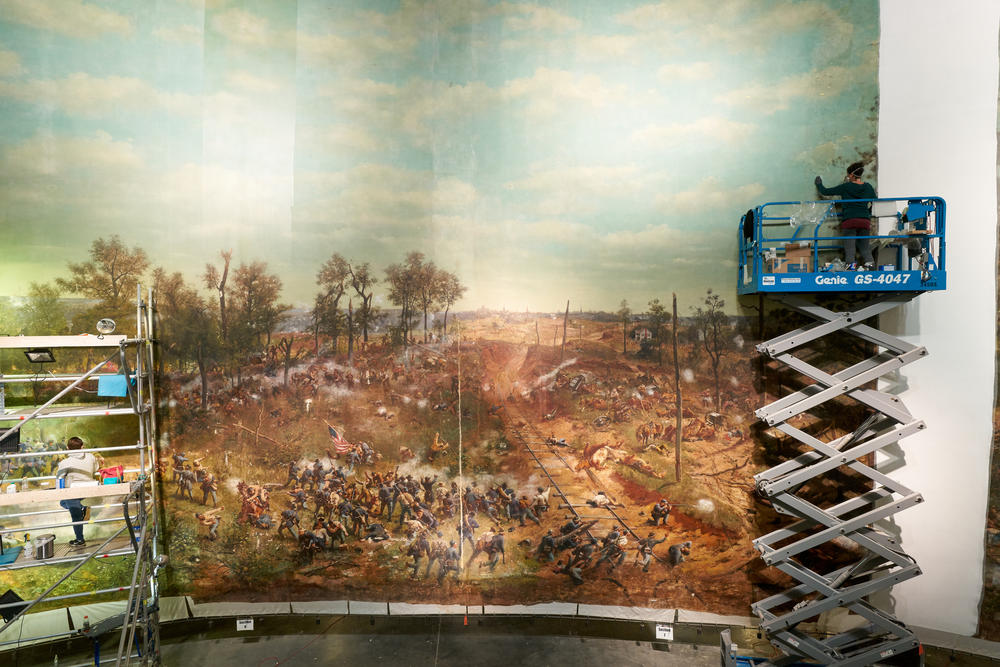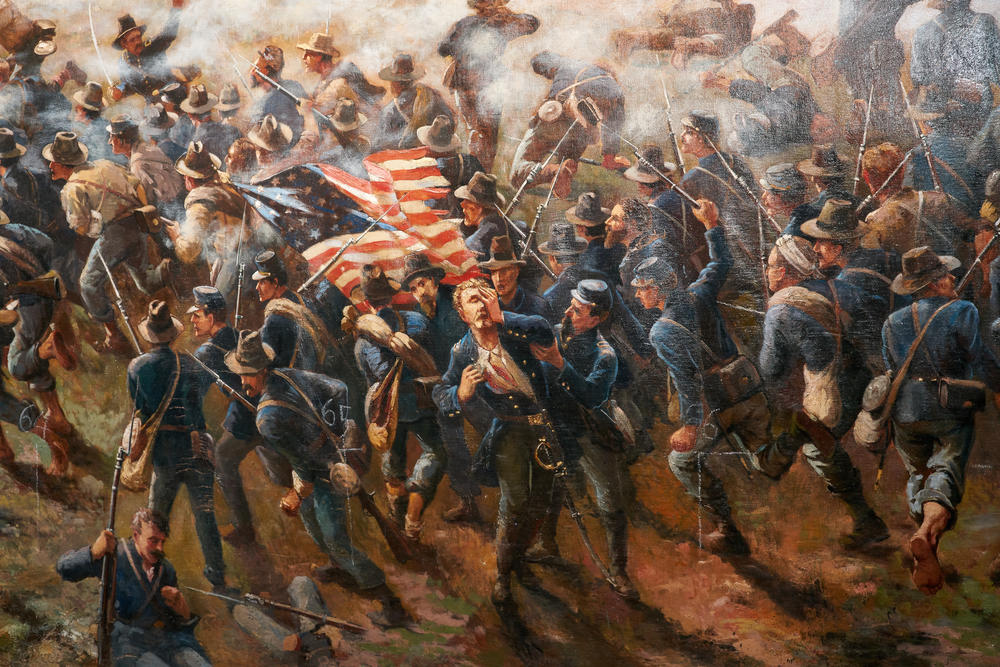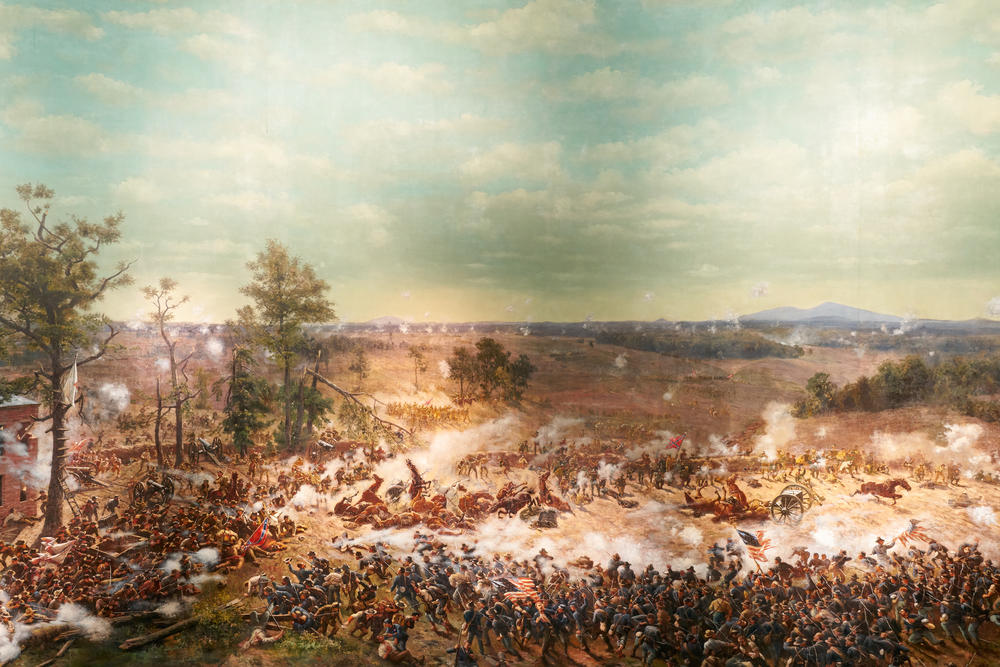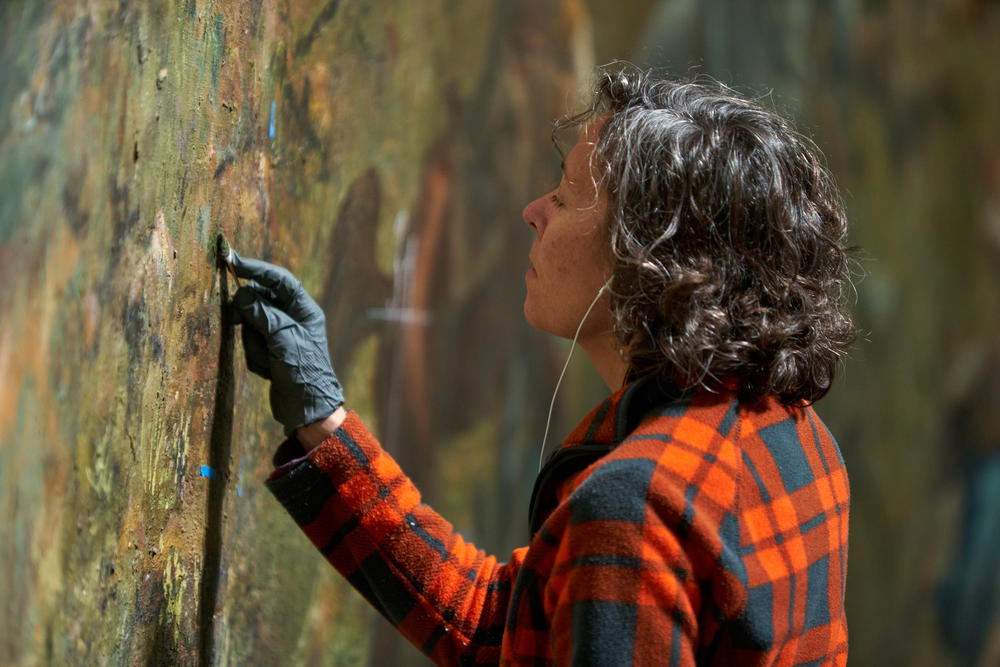Section Branding
Header Content
Getting History Right With The Battle of Atlanta Cyclorama
Primary Content
When the panoramic painting known as the Battle of Atlanta Cyclorama opened in 1886 in Wisconsin, its Northern audience delighted in celebrating the North’s Civil War victory over the South.
Most American adults had lived through the historic conflict stretching from 1861 and 1865.
But after the cyclorama moved to Atlanta in 1892, both the canvas and the story of the battle were reshaped into a point of Southern pride.
Step inside history
To see the Battle of Atlanta Cyclorama, you literally have to step inside it and take an escalator up to a 15-foot-tall viewing platform. At the top, you're enclosed by an enormous circular landscape painting.
It’s a bit overwhelming and akin to walking into a cathedral. It’s 49 feet high, slightly bigger around than a football field and weighing 10,000 pounds.
"This is a history of Civil War memory through one of the biggest, most bodacious artifacts you could ever have," said Sheffield Hale, Atlanta History Center President and CEO.
Spinning around 360 degrees, the effect is a lot like being on the battlefield. From the platform, we’re looking westward toward downtown Atlanta as though we’re standing in what’s Atlanta’s Inman Park neighborhood.
"In front of you is the Inman Park MARTA station. Over there to your right is Kennesaw Mountain and Stone Mountain on the other side," said Hale, pointing to places on the painting where modern-day landmarks are today.
The dramatic scene surrounds us took place 155 years ago.
On the battlefield
It’s a sunny summer day with a clear blue sky expanding in quiet contrast over the calamity below.
Hundreds of tiny painted figures are scattered across the red clay earth. Tangled groups of men are firing guns and cannons, thrusting swords, running, falling, punching and kicking.
It’s chaos.
Some figures appear to be dead or dying.
Dotting the carnage are white puffs of smoke bursting above the fray. Occasionally, the eye catches the bright red of a Confederate flag or the navy blue of Old Glory.
You can almost hear the barrage of gun powder blasts as thousands of terrified men cry out in a cacophony of pain and triumph and fear.
Declaring victory and virtue
This scene depicts a terrible day for the Southern cause. Confederates lost 5,500 troops while failing to repel Union forces who would go on to take Atlanta only six weeks later.
Artists in Milwaukee in the 1880s knew their Northern audience would be eager to re-live Union soldiers crushing Confederate rebels only two decades earlier.
And yet, six years after it debuted in Wisconsin, the cyclorama arrived in Atlanta billed as the “only Confederate victory every painted.”
"It took on this Confederate tinge," said Hale. "This pro-Southern aura of the Lost Cause and reconciliation that both sides were valiant and that it was just a big misunderstanding.”
The 1890s were a period of historic and cultural revisionism that would become known as the Lost Cause. In this sanitized version of the Civil War, Confederates weren’t so much defending slavery as they were protecting their homes, families and way of life against Northern invaders.
“Slavery wasn't talked about at all,” said Hale.
For the next century, the Battle of Atlanta Cyclorama became a vehicle for the Lost Cause narrative.
What visitors heard in 1940
In a 1940 audio tour of the Battle of Atlanta Cyclorama exhibit, visitors were led to believe that a scene depicting a Union victory actually shows a Confederate triumph.
"To the right of the house are the abandoned guns of the DeGress Battery, now in possession of the victorious Confederates. And in mangled heaps on the ground are the carcasses of the battery horses slain by the retreating gunners and by nearby artillery fire. This is the high moment of the day for the Confederate forces. We will notice as we proceed that the entire picture is built around this episode.”
In truth, Union troops were seconds away from recapturing the battery of cannons.
While it’s accurate to say the painting is built around this scene, the narration misled visitors by suggesting the scene depicts a Confederate victory.
The painting is built around a Union triumph late in the afternoon, not an earlier, momentary gain by Confederates.
What visitors heard in 1959
By 1959, the Lost Cause propaganda was arguably worse.
Curators produced a highly dramatized audio tour with theatrical language over the Confederate anthem, ‘Dixie.’
The effect is to glorify Southern fighters battling for a just cause against an unjust foe. This segment of a 1959 Battle of Atlanta Cyclorama audio tour uses dramatic music and theatrical language to glorify the Confederate cause.
"Capture the hill! Attack! Again, again, again! Fight! Fight until you die! And die they do by the thousands in the face of the superior strength and arms of the Union forces. Under their banner of pure white stars and royal blue bars on a field of blood red, these lads become fighting men. But their individual courage cannot overcome the overwhelming odds.”
It’s notable that this narration goes on to characterize the Civil War as a conflict of political equals.
To many, including the painting’s original Northern audience, the Civil War was a matter of the powerful federal government squelching a rebellion of a few poorly-armed, slaveholding states.
“This memorial to the war between the states is a fitting tribute. Never forget that war. For it was on the hot forge of blazing battlefields like this that the steel strength of this nation was forged. Here were principles established. Here where the bonds of unity were tested and strengthened. Here, from this battle and others like it, emerged the United States of America.”
On the contrary, the principle that the South was fighting for – slavery - wasn’t established. It was violently destroyed.
And unity was far from the minds of Confederates on this battlefield.
What visitors will hear now
Today’s visitors to the Battle of Atlanta Cyclorama will learn the whole story of the battle.
The Center has invested $36 million into restoring the painting and its accompanying diorama.
The installation includes new galleries, a historic steam locomotive, high-tech interpretative videos, audio tours and displays.
Visitors will also learn the story of the painting.
It’s itself an artifact illustrating how different generations have told differing stories about why three million Americans spent four years trying to kill one another.
"History is messy and complicated. People can hold two ideas in their head at the same time,” said Hale.
“We're not here trying to convert somebody. We're trying to get them to think about history and what they were told and let people come to their conclusions.”
People can come to their conclusions starting Friday when the Battle of Atlanta Cyclorama re-opens to the public at the Atlanta History Center.





